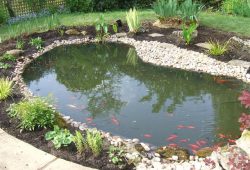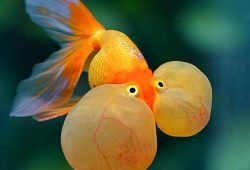Winter Maintenance in the Frozen Koi Pond
In this article I’ll tell you about Winter Maintenance in the Frozen Koi Pond.

Contents
- 1 Clean the Pond, Use Thermoclines, Reduce Feeding, and Turn Off Pumps
- 2 Why Let a Pond Freeze in the Winter?
- 3 Dig a Deep Pond to Help Koi and Other Fish Survive
- 4 Reduce Fish Feeding to Prepare the Pond for Winter
- 5 Fall Pond Maintenance Helps Fish Survive the Winter
- 6 Encourage Warm Water to Stay on the Pond Bottom
- 7 Break the Ice for an Air Hole Without a Deicer
Clean the Pond, Use Thermoclines, Reduce Feeding, and Turn Off Pumps
In the winter, ponds tend to freeze over. This is not a problem for humans who happily don gloves and jackets and go skating. For koi and other pond animals, life in a small, frozen pond can be a challenge. There are two approaches to winter pond maintenance: let the pond freeze, or keep the pond warm.
Why Let a Pond Freeze in the Winter?
Letting a pond freeze is the most natural and lowest maintenance way to deal with a pond in the winter time. Fish can come indoors or go to the bottom of the pond. There may be some loss of fish, but planning can help fish survive the winter. This natural approach avoids the need to run pond deicers and heaters.
Dig a Deep Pond to Help Koi and Other Fish Survive
In nature, a pond will freeze over on the top. Frequently, the pond will not freeze all of the way to the bottom. Warmer water actually tends to sink, creating a thermocline – a stratification of pond water. Frogs and fish can settle down into a winter hibernation at the bottom of the pond. Their body functions slow down and they become dormant to survive the winter. For those who choose to have the pond freeze on top, make sure that the pond is at least three meters deep, deep enough to afford the fish some living space at the bottom.
Reduce Fish Feeding to Prepare the Pond for Winter
As the fall begins, the days get shorter. Animals prepare for winter. Those animals who hibernate begin to slow down their metabolic processes. As they do so, it’s important to reduce feeding of the fish until they are not eating anything in the winter time. Fish are not like people – they do not require three meals a day. Fish can eat in the summer and fast in the winter time. In fact, this is what they will naturally do. Adding more fish food to the pond will simply add decomposing matter to a pond ecosystem that is slowing down for the winter.
Fall Pond Maintenance Helps Fish Survive the Winter
While natural ponds will have some leaves at the bottom, the ponds around most homes have more fish than a tiny natural pond would contain. These fish create wastes and leave uneaten food, adding nutrients to the water. This means that small ponds require diligent maintenance to control additional organic debris that might enter the pond. In the fall, use a net or a pond skimmer to catch leaves and other debris that could enter the pond. This will keep the pH of the pond healthy during the fall and winter season.
Encourage Warm Water to Stay on the Pond Bottom
If possible, move the pond pump off the bottom. The goal is to keep the deep water as warm as possible. Bubblers or aerators can be turned off in the winter time. Keeping the water stable helps it stay warm on the bottom. If the weather becomes extremely cold, it may be practical to stop the pump for a time.
Break the Ice for an Air Hole Without a Deicer
With diligent maintenance, it is often possible to create an air hole for fish without a deicer. Choose a place where the ice is weak because a pond ornament or plant is poking through. If a waterfall remains on during the winter, use it to create a hole. If the pond does freeze over, use a hot pan to create another hole.
Keeping fish in a pond over the winter does require fall and winter maintenance. However, letting a pond freeze over is the least expensive way to overwinter a fish pond. By removing organic material, reducing fish feeding, and encouraging the development of a warm area in the pond, fish can remain healthy all winter.



